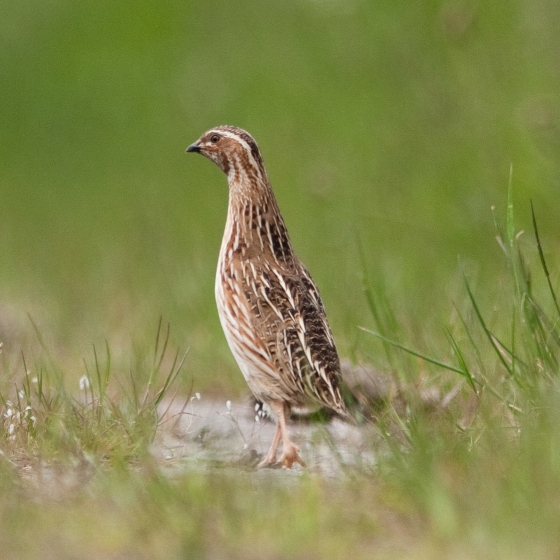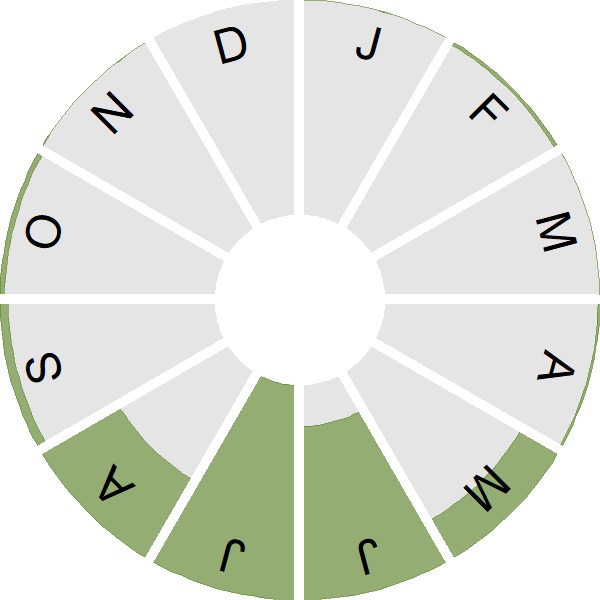Quail

Introduction
This small gamebird is secretive and hard to see, although its characteristic sweet 'wet-my-lips' call gives away its presence in the countryside.
The Quail is a summer visitor to Britain, and may be encountered anywhere in lowland Britain where there is plenty of arable farmland and open grassland. Quail arrive very late in spring and early summer.
In some years – known as a 'quail year' – the numbers arriving in Britain are much larger than usual. BirdTrack data show 2011 to be one such year, when the number of singing males reported approached 2,000 birds. That year there was also an unusual concentration of birds in the southern Scottish Borders.

Key Stats
Identification
Songs and Calls
Song:
Call:
Flight call:
Status and Trends
Conservation Status
Population Change
This summer migrant is monitored by the RBBP but its status is difficult to assess as numbers can fluctuate from year to year. Occupation is often sporadic and birds do not necessarily use the same sites each year. Occasional invasions ('Quail years') occur and may be caused by spring weather conditions although this is unclear. RBBP data suggest that numbers in the UK have been stable over the 25 years to 2019 and show a five-year mean of 370 males over the period 2015–2019 (Eaton et al. 2021). The same report suggests a northward shift in mean breeding latitude of almost 5 km per annum has occurred over the last 30 years
Distribution
Quail breeding season records are distributed throughout lowland England, where arable farmland and open grassland predominate, plus in a narrow band along the eastern side of Scotland as far north as Shetland.
Occupied 10-km squares in UK
or view it on Bird Atlas Mapstore.
or view it on Bird Atlas Mapstore.
European Distribution Map
Distribution Change
As Quail numbers vary markedly from year to year, range changes depend on how many 'Quail years' each atlas experienced. Nevertheless, areas of calcareous soils in southern Britain seem to be consistently occupied in all atlases.
Change in occupied 10-km squares in the UK
or view it on Bird Atlas Mapstore.
or view it on Bird Atlas Mapstore.
Seasonality
Quails are summer visitor, mostly arriving from late May onwards. After July probably under-recorded once males stop singing.
Weekly pattern of occurrence
The graph shows when the species is present in the UK, with taller bars indicating a higher likelihood of encountering the species in appropriate regions and habitats.

Movement
Britain & Ireland movement
Foreign locations of birds ringed or recovered in Britain & Ireland
Dots show the foreign destinations of birds ringed in Britain & Ireland, and the origins of birds ringed overseas that were subsequently recaptured, resighted or found dead in Britain & Ireland. Dot colours indicate the time of year that the species was present at the location.
- Winter (Nov-Feb)
- Spring (Mar-Apr)
- Summer (May-Jul)
- Autumn (Aug-Oct)

European movements
EuroBirdPortal uses birdwatcher's records, such as those logged in BirdTrack to map the flows of birds as they arrive and depart Europe. See maps for this species here.
The Eurasian-African Migration Atlas shows movements of individual birds ringed or recovered in Europe. See maps for this species here.
Biology
Productivity and Nesting
Nesting timing
Egg measurements
Clutch Size
Survival and Longevity
Survival is shown as the proportion of birds surviving from one year to the next and is derived from bird ringing data. It can also be used to estimate how long birds typically live.
View number ringed each year in the Online Ringing Report.
lifespan
Survival of adults
Biometrics
Wing length and body weights are from live birds (source).
Ring Size
Classification, names and codes
Classification and Codes
- Order: Galliformes
- Family: Phasianidae
- Scientific name: Coturnix coturnix
- Authority: Linnaeus, 1758
- BTO 2-letter code: Q.
- BTO 5-letter code: QUAIL
- Euring code number: 3700
Alternate species names
- Catalan: guatlla comuna
- Czech: krepelka polní
- Danish: Vagtel
- Dutch: Kwartel
- Estonian: põldvutt
- Finnish: viiriäinen
- French: Caille des blés
- Gaelic: Gearra-gart
- German: Wachtel
- Hungarian: fürj
- Icelandic: Kornhæna
- Irish: Gearg
- Italian: Quaglia
- Latvian: paipala
- Lithuanian: paprastoji putpele
- Norwegian: Vaktel
- Polish: przepiórka (zwyczajna)
- Portuguese: codorniz
- Slovak: prepelica polná
- Slovenian: prepelica
- Spanish: Codorniz común
- Swedish: vaktel
- Welsh: Sofliar
Research
Causes of Change and Solutions
Causes of change
The breeding range of Quail has shifted northward in Europe, including within the UK, over the last 30 years (Keller et al. 2020; Eaton et al. 2021). Whilst the reasons for this shift are still unclear, it is suspected that differences in numbers of Quail could be linked to weather conditions, and hence it is feasible that long-term changes in Quail distribution could be linked to climate change.

